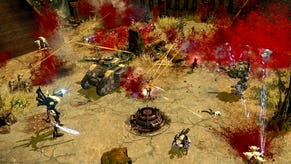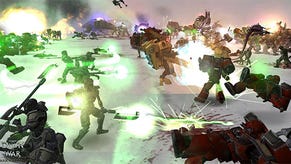More DoW2 Multiplayer Wordthinks
So I've had a bit more time on the Dawn Of War 2 multiplayer beta, and some thoughts come to mind. I've written them up after the jump, and I'm fairly certain you'll tell me whether or not you agree.
Different, and yet agreeably samey. Less of a battle and more of a brawl. That's how I'm feeling about Dawn of War 2. I love the spread of options that the four races (and three hero-types per race) provide, and I'm also glad of the absurd Warhammer 40k bombast that was so perfectly pitched in the original. Fights are ostentatious, macho, and bloody. Not-quite-cartoon brutality that makes this entertaining even when you lose. Just the way we like it. The entire game is a little closer in, and much better defined. Everything, from the main menu inwards, is swathed in useful detail. It has a sense of purpose. I love the jungle map, and the Tyranids hiss and shriek just so.
Early on, I wasn't so sure. The focus on your units, particularly your hero, rather than your structures, is a distinct and far-reaching change. And it's blatantly clear that the game can be won or lost in the opening couple of minutes, which I've heard a few grumbles about. That's true, but this does not mean that it will be lost in that period, which is quite a different conclusion. In actual fact, if teams manage to deploy fairly evenly in those opening moments, and keep their core assets reasonably well defended, then a proper scrap can emerge.
That's not to say it's quite what I wanted. I do miss being able to build a large complex of buildings, and especially turrets. As that kind of player I was, of course, drawn to play the defensive hero classes. The techmarine was particularly satisfying, and I managed to do fairly well in early games by spamming Tarantula turrets across my most sensitive areas. Immediately these kinds of units begin to reveal what is interesting about DoW2, with the techmarine levelling up, and the turrets suppressing enemy units. The heavy weapons really do feel heavy in this game, not just because of the suppression effect, which slows enemy assaults, but also because of the visual splatter of them. The effects rip across the map in a most satisfying manner. They are big guns wot shoot like big guns should
And assuming things don't fold in the first few minutes, the game really does begin to open up in an interesting way, thanks to that levelling dynamic. The fights become fiercer, more likely to be turned by the sudden burst of a special power. (Possibly at the risk of there being too much micromanagement? I can't tell yet.) This time the upward spiral of firepower is not simply thanks to base upgrades giving you more tiers of units, but in the clear focus on sexy equipment. Pretty much everyone can be upgraded, with the hero getting three slots for special abilities and additional powers. Once these are in-play then the micro-level of the actual fights become a good deal more compelling. Once again Relic have aced the fighting animations, and watching an Ork warboss beat the hell out of a Tyranid hive tyrant makes for happy nerding.
All this stuff benefits from the lessons learned via Company of Heroes too, with the use of both cover and structures. This I really do approve of. Dawn of War battlefields are no longer fancy, but essentially featureless, playing fields. Instead - as in CoH - the entire thing is enriched by their being made up of a network of possible chokepoints and entrenchment lines. This makes the battles feel far more malleable: you sense there's more to master, and more options to play with. More to worry about, too. The cover system doesn't always seem to work for squads, with one dude almost always standing out in the open, but it's an addition that seems to genuinely rejig the way you have to think, if you want to win.
Of course, having been a complete junkie for hugely unit-rich base-building mega-battles in the original game, I do feel a little disappointed by the pared down, smaller feel of the multiplayer ways, and it makes me fear for the single player too. But that feeling is nevertheless offset by the general new-and-improved shininess of the game. This is one of the instances where a small step up in technology and design talent makes a rather major difference. They're a couple of games wiser and smarter, and my newer, beefier PC is happy to shoulder the extra graphical load. The tigher focus seems to have brought some details to the fore, and make the large units all the more essential, and impressive.
Once again the Relic team seems to have captured what's interesting about Games Workshop's grim 41st century of Only War, and yet still made it colourful and approachable. So approachable, in fact, there's something quite Blizzardian about it. It's got that kind of sheen, which seems appropriate, given the history. And that user-friendliness will make the contrast with ultra-traditional Starcraft 2 all the more interesting. It does feel like Relic are making the bolder moves in the RTS world, but whether that will count for much in the race for sales and general acclaim, it's hard to say. Maybe. I hope so.
We'll be talking a load more about Dawn Of War 2, which is set for release on 19th/20th February, in a couple of weeks.










